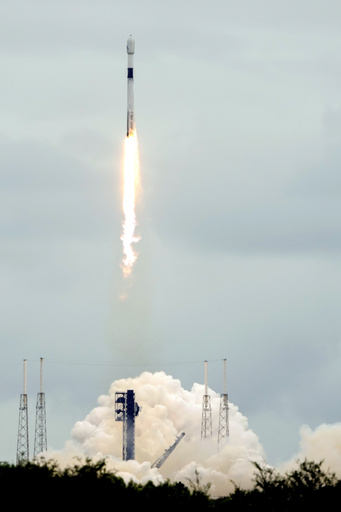CAPE CANAVERAL, Fla. — A spacecraft launched on Monday to delve into the aftermath of a cosmic collision. The European Space Agency’s Hera spacecraft embarked on a two-year mission to explore a small, non-threatening asteroid that was struck by NASA two years prior. This event was part of a planetary defense exercise aimed at preparing for potential threats from a destructive asteroid heading towards Earth. Hera’s launch represents the second phase of this critical defensive test, which may be crucial for future planetary safety.
The spacecraft, carried by SpaceX’s Falcon rocket, vanished into the clouds shortly after takeoff. An hour later, cheers filled the control room in Germany when Hera successfully separated from the rocket’s upper stage and communicated its status. “It’s an amazing day,” remarked Josef Aschbacher, the agency’s director general.
NASA’s Dart spacecraft previously collided with the asteroid Dimorphos in 2022, successfully reducing its orbital period around its larger neighbor. This demonstrated that, should a hazardous asteroid be on a collision course with Earth, it might be diverted with adequate planning and time.
Experts are keen to closely observe the impact’s consequences to better understand Dart’s effectiveness and identify possible modifications for future protective strategies. “The more detail we can glean, the more valuable it will be for planning any potential deflection missions in the future,” stated Derek Richardson, an astronomer at the University of Maryland, prior to the spacecraft’s launch.
Researchers are investigating whether Dart left a permanent crater or drastically altered the shape of the 500-foot (150-meter) asteroid. Before the collision, Dimorphos was likened to a flying saucer, and it may now take on a shape similar to a kidney bean, according to Richardson, who was part of the Dart project and is involved with the Hera mission.
The impact from Dart sent rock fragments and boulders scattering from Dimorphos, enhancing the momentum of the collision. A significant debris trail formed, stretching thousands of miles (over 10,000 kilometers) into space and persisting for several months.
Some of the leftover debris and boulders may still orbit the asteroid, potentially posing risks to Hera’s operations, warned flight director Ignacio Tanco. “We don’t fully understand the environment we will encounter,” Tanco commented, emphasizing the mission’s ultimate goal of uncovering these mysteries.
European officials have dubbed the €363 million ($400 million) mission a “crash scene investigation.” “Hera is returning to the scene of the incident to gather both scientific and technical data,” explained project manager Ian Carnelli.
Equipped with a dozen scientific instruments, Hera, which is about the size of a small car, will require a gravity assist from Mars in 2025 before it reaches Dimorphos by late 2026. At that point, the two asteroids will be located approximately 120 million miles (195 million kilometers) from our planet.
Hera aims to enter orbit around the asteroid duo, initially swinging by from 18 miles (30 kilometers) away and gradually getting as close as half a mile (1 kilometer). The spacecraft will observe Dimorphos for at least six months to determine its mass, shape, composition, and its orbital characteristics relative to Didymos, the larger body.
Prior to the collision, Dimorphos orbited Didymos from a distance of approximately three-quarters of a mile (1,189 meters), but scientists now anticipate a tighter, more elliptical orbit and speculate that the moonlet may be tumbling.
In addition, two small Cubesats will detach from Hera for more detailed inspections, including the use of radar to investigate the moonlet’s rocky surface. Scientists believe Dimorphos may have originated from materials ejected by Didymos. Radar data will help clarify the relationship between the two asteroids.
Once their inspections are finalized, the Cubesats will endeavor to land on Dimorphos. If the moonlet is indeed tumbling as expected, landing could be particularly challenging. Hera may also conclude its mission with a landing attempt on the larger Didymos.
Importantly, neither of these asteroids poses a risk to Earth—prior to or following Dart’s impact. This was a significant factor in NASA’s choice of the asteroid pair for the first-ever demonstration of asteroid deflection.
Asteroids, remnants from the solar system’s formation around 4.6 billion years ago, mainly orbit between Mars and Jupiter in the main asteroid belt, where millions exist. They are categorized as near-Earth objects when they are displaced from their original paths into our vicinity.
Currently, NASA identifies over 36,000 near-Earth objects, predominantly asteroids but also some comets, with more than 2,400 categorized as potentially hazardous to Earth.




